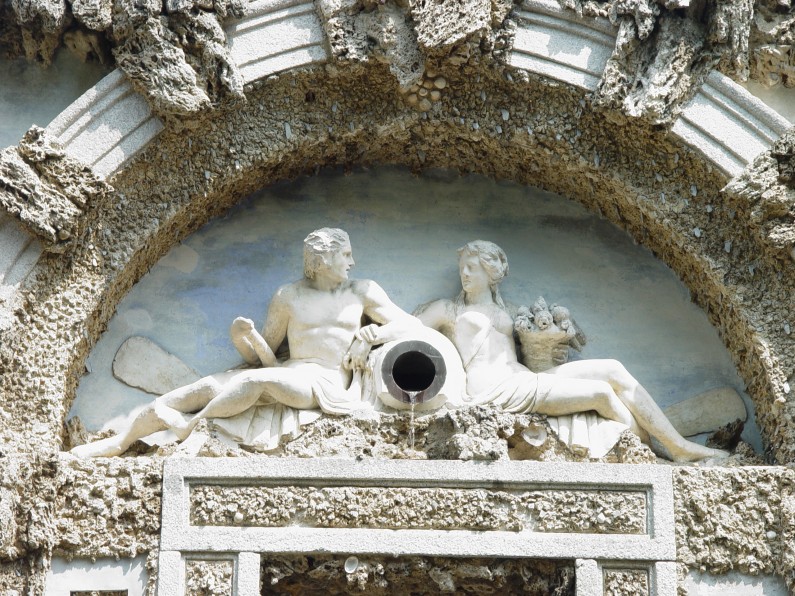
The architectural complex known as the “Nymphaeum” consists of a succession of seven areas (including artificial caves) and 12 rooms arranged symmetrically around an octagonal room called the “Atrium of the four winds.”
More
These housed the collections of paintings, fossils, minerals, coins, relics, mechanical instruments and archaeological finds of the Borromeo Visconti Litta families. The complex was built between 1585 and 1589 at the behest of Pirro Visconti Borromeo I, by the architect, Martino Bassi (1542-1591), active in the same years at other sites owned by the family. Here, he reassumed a type of architecture inspired by the design of the architect, Sebastiano Serlio who did the gardens of the king of France in Fontainbleau, and whose style was widely diffused in Renaissance and Baroque gardens in Europe.
The decoration of the rooms of the “Nymphaeum” is characterized by mosaic walls and floors made with round, white (quartz) and black (limestone) pebbles placed in such a way as to form intricate weavings of geometric motifs, and floral scrolls. Legendary creatures (sphinxes, fauns, centaurs, unicorns, dragons, snakes, lions, harpies, winged horses) listless in their painted cages, unfold on the walls and floors without any continuity. In these mosaic stones, transpire all the knowledge and decorative repertoire of plasterers, gunsmiths, tailors, embroiderers, jewellers and engravers; Pirro Visconti Borromeo I often acquired samples, displaying them next to the mosaics as if they were a collection of shapes and decorative patterns.
Even more particular are the pebble decorations painted on the ceiling of the northern sector, an absolutely original technique devised by different master craftsmen. The painter delineated the outlines of the design with the pouncing technique which was subsequently done by mosaic masters with round and white pebbles following the preparatory drawing. This was then painted with tempera colours (turquoise, sienna, two shades of ochre) exploiting the natural white stones for more colour contrasts. This very special work was carried out between 1587 and 1589 by Camillo Procaccini (1561-1629), an artist from Emilia, who trained in the workshop of the Bolognese, Carracci; he arrived in Milan on the express invitations of Pirro Visconti Borromeo I and his artistic advisor, Gian Paolo Lomazzo, to work among the caves in Lainate. Here the young artist betrayed his passion for the paintings of Correggio, whose figures were used as models for centaurs, fauns and nymphs, and whose varied portraits he foreshortened and twisted from the works of the naturalist Ulisse Aldrovandi, who provided a real reference book of imaginary beings delineated between science, myth and legend.
All the areas of the Nymphaeum are enriched by statues in stucco and white marble, mainly representing characters and gods of ancient mythology that critics attribute, with regard to the models and as overall director of the whole works, to the Lombard sculptor Francesco Brambilla the Younger (d. 1599), who was also active in the “Fabbrica del Duomo/ construction site of the cathedral” in Milan.
The decoration of the rooms of the “Nymphaeum” is characterized by mosaic walls and floors made with round, white (quartz) and black (limestone) pebbles placed in such a way as to form intricate weavings of geometric motifs, and floral scrolls. Legendary creatures (sphinxes, fauns, centaurs, unicorns, dragons, snakes, lions, harpies, winged horses) listless in their painted cages, unfold on the walls and floors without any continuity. In these mosaic stones, transpire all the knowledge and decorative repertoire of plasterers, gunsmiths, tailors, embroiderers, jewellers and engravers; Pirro Visconti Borromeo I often acquired samples, displaying them next to the mosaics as if they were a collection of shapes and decorative patterns.
Even more particular are the pebble decorations painted on the ceiling of the northern sector, an absolutely original technique devised by different master craftsmen. The painter delineated the outlines of the design with the pouncing technique which was subsequently done by mosaic masters with round and white pebbles following the preparatory drawing. This was then painted with tempera colours (turquoise, sienna, two shades of ochre) exploiting the natural white stones for more colour contrasts. This very special work was carried out between 1587 and 1589 by Camillo Procaccini (1561-1629), an artist from Emilia, who trained in the workshop of the Bolognese, Carracci; he arrived in Milan on the express invitations of Pirro Visconti Borromeo I and his artistic advisor, Gian Paolo Lomazzo, to work among the caves in Lainate. Here the young artist betrayed his passion for the paintings of Correggio, whose figures were used as models for centaurs, fauns and nymphs, and whose varied portraits he foreshortened and twisted from the works of the naturalist Ulisse Aldrovandi, who provided a real reference book of imaginary beings delineated between science, myth and legend.
All the areas of the Nymphaeum are enriched by statues in stucco and white marble, mainly representing characters and gods of ancient mythology that critics attribute, with regard to the models and as overall director of the whole works, to the Lombard sculptor Francesco Brambilla the Younger (d. 1599), who was also active in the “Fabbrica del Duomo/ construction site of the cathedral” in Milan.
